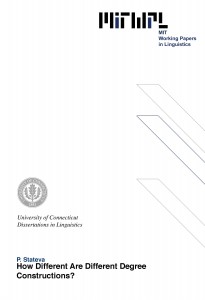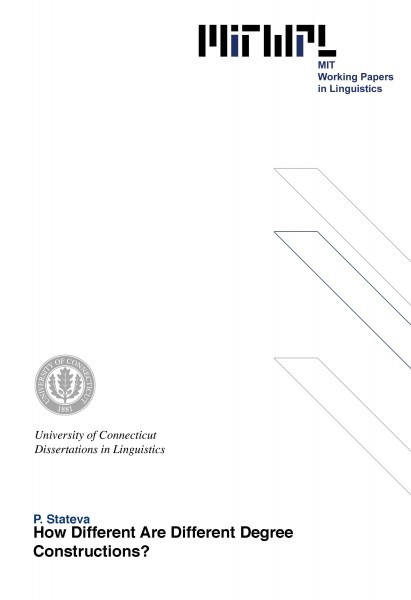How Different Are Different Degree Constructions?
P. Stateva, 2002
ABSTRACT
At least from the point of view of English, it seems plausible that the comparative and the superlative degree words more/less and most/least have similar syntactic and semantic properties. This dissertation is concerned with the question whether the intuition is in fact warranted. Our discussion is based on a comparative study of the two comparison constructions in different syntactic environments like so -pronominalization, measure phrases, conditional sentences, etc. Benefiting from a cross-linguistic perspective, we argue that the comparative and the superlative constructions differ in many dimensions, the most important of which is the quantificational force of the degree words. We continue a debate about the quantificational status of degree operators between Kennedy (1999) and Heim (2000) and bring evidence that the comparative degree word is a scope bearing element, while the superlative isn't. To motivate our view, we examine patterns of scope interactions in the comparative conditional construction, and also split scope phenomena. Finally, we propose a non-unifying semantic and syntactic theory of comparison.
We give special attention to the question why the effects of the scopal properties of the comparative operator are difficult to be attested. Building on a suggestion in Heim (2000) we examine the role of syntax in scope interactions between the comparative operator and other scope bearing elements. We reevaluate Heim's interface constraint, known as Kennedy's generalization and in light of new data that we discuss, we propose this constraint to be reduced to a more general constraint about intervention effects of quantifiers, independently motivated in Beck (1996).
As a consequence of our proposal, the following picture about natural language comparison emerges: comparison can be encoded either non-quantificationally, or quantificationally. The superlative construction realizes the first option. The adjectives/adverbs on which it is based have a semantic type of a measure function in the spirit of Kennedy (1999). The second option is instantiated in the comparative construction. In it, the type of adjectives/adverbs is raised to provide a degree variable which the comparative operator binds, and thus quantifies over part of a scale. That view eliminates the undesirable consequence of other quantificational theories that the absolute adjectival construction has a built-in quantifier.
Table of Contents
Chapter l A Common sense theory of the comparative and superlative degree words
1. l. Mainstream assumptions about comparatives .............................................10
1.1.1. A quantificational type of analysis ..............................................................10
1.1.2. A non-quantificational type analysis ..................................................15
1.2. Mainstream assumptions about superlatives ...............................................20
1.2.1. A quantificational type of analysis .....................................................................20
1.2.2. A non-quantificational type of analysis ..............................................................26
1.3. Common properties of comparison constructions ........................................32
1.3.1. Patterns with ambiguities ...................................................................................32
l.3.2. Comparison classes ......................................................................38
1.4. The syntax comparative and superlative constructions ....................................40
1.4.1. The comparative construction ..,.......................................................41
1.4.l.l. Comparative and ellipsis .........................................................41
l.4.l.2. What is the head of a degree construction? ....................................44
1.4.1.3. Syntactic proposal ...............................................................48
1.4.2. Superlatives ...............................................................................53
1.5. The common-sense' proposal ................................................................56
Chapter 2 Problems for the common-sense theory
2.1. Asymmetries between the comparative and the superlative constructions ................67
2.l.1. Sandwich" contexts ......................................................................68
2.1.2. So-pronominalization and superlatives ...............................................71
2.1.3. Measure phrases .........................................................................72
2.1.4. Comparative conditionals/*superlative conditionals ................................74
2.1.5. The comparative and the superlative in syntactic islands ...........................75
2.1.6. Possessive superlatives/ *possessive comparatives .................................78
2.1.7. Modal adjectives and comparison .....................................................79
2.2. DegP scope in comparative conditionals ....................................................80
2.3. Problems with detecting DegP movement .................................................82
2.3.1. Heimʼs Kennedy generalization .......................................................82
2.3.2. LF movement out of a definite description? .........................................86
2.4. Conclusion .....................................................................................87
Chapter 3 Proposal: a non-unifying theory of comparison - comparatives have
significant scopal properties, superlatives donʼt
3.1. The analyses ....................................................................................88
3.1.1. Comparatives .............................................................................89
3.1.2. Superlatives ..............................................................................91
3.1.2.l . The quantificational DP-internal view ........................................91
3.1.2.2. The reductionist view - a non quantificational theory of superlatives ...102
3.1.2.3. Two types adjectives? ..................................................................114
3.2. Empirical consequences .....................................................................115
3.2.l. Measure phrases explained ............................................................115
3.2.2. So-pronominalization contrast explained ...........................................118
3.2.3. Comparative conditionals again ......................................................120
3.2.3.1. The semantics of construction: Beck (1997) ...............................121
3.2.3.2. Ambiguities in CCs: comparatives do have significant scope ............124
3.1.3.3. Why are there no superlative conditionals? .................................134
3.2.4. Other scope ambiguities with comparatives ........................................136
3.2.5. Upstairs de dicto readings in superlatives ........................................138
3.2.6. Comparison and relative clauses revisited ..........................................149
3.2.7. Conclusion ..............................................................................152
Chapter 4 Intervention effects
4.1. The status of Kennedys generalization ..................................................................154
4.l.l. A Puzzle ..................................................................................154
1.4.2. Independent evidence for the constraint on LF movement ........................163
4.2. Plural operators as interveners .............................................................167
4.2.1. The distributive operator ..............................................................168
4.2.2. The cumulative operator ...............................................................170
4.3. A derivational versus a representational approach to locality of LF movement .....173
Chapter 5
5.1. Schwarzschild and Wilkinsons problem and MQSC .................................178
5.2. Comparison in natural language ...........................................................185
References ..........................................................................................

